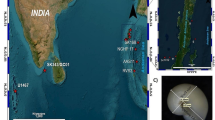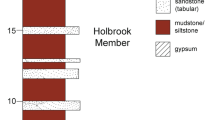Abstract
The Silurian of Gotland, Sweden, consists of 440 m of carbonate deposits. Repeatedly, uniform sequences of micritic limestones and marls are interrupted by complex-structured reefs and by adjacent platform sediments. Generally, the alteration of facies is interpreted as the result of sea-level fluctuations caused by a gradual regression with superimposed minor transgressive pulses. The purpose of this study is a facies interpretation based on both field observations and stable isotope measurements of brachiopod shells. Approximately 700 samples from stratigraphically arranged localities in different facies areas have been investigated. The carbon and oxygen isotopes show principally parallel curves and a close relationship to the stratigraphic sequence. Lower values occur in periods dominated by deposition of marly sequences. Higher values are observed in periods dominated by reefs and extended carbonate platforms. The oxygen isotope ratios are interpreted to reflect paleosalinity changes due to varying freshwater input, rather than to paleotemperature. Carbon isotope ratios are believed to have been connected to global changes in the burial of organic carbon in black shales during periods of euxinic deep water conditions. Consequently, the facies succession on Gotland results from global paleoclimatic conditions. Changes in terrigenous input due to different rates of weathering and freshwater runoff, rather than sea-level fluctuations, control the carbonate formation of the Silurian on Gotland.
Similar content being viewed by others
References
Aldridge RJ, Jeppsson L, Dorning KJ (1993) Early Silurian oceanic episodes and events. J Geol Soc Lond 150:501–513
Berger WH, Vincent E (1986) Deep-sea carbonates: reading the carbon-isotope signal. Geol Rundsch 75:249–269
Broecker WS, Denton GH (1989) The role of ocean-atmosphere reorganizations in glacial cycles. Geochim Cosmochim Acta 53:2465–2501
Brood K (1976) Bryozoan palaeoecology in the Late Silurian of Gotland. Palaeogeogr Palaeoclimatol Palaeoecol 20:187–208
Charles CD, Fairbanks RG (1992) Evidence from Southern Ocean sediments for the effect of North Atlantic deep-water flux on climate. Nature 355:416–419
Cherns L (1983) The Hemse-Eke boundary, facies relationships in the Ludlow series of Gotland Sweden. Sveriges Geologiska Undersökning C 800:3–45
CLIMAP Project Members (1981) Seasonal reconstructions of the earth’s surface at the last glacial maximum. GSA Map and Chart Ser MC-36, Boulder, Colorado
Craig H, Gordon LI (1965) Deuterium and oxygen-18 variations in the ocean and marine atmosphere. In: Tongiorgi E (ed) Stable isotopes in oceanic studies and paleotemperatures. Consiglio Nazionale Delle Ricerche, Laboratorio di Geologia Nucleare, Pisa, pp 9–130
Epstein S, Buchsbaum R, Lowenstam HA, Urey HC (1953) Revised carbonate-water isotopic temperature scale. Bull Geol Soc Am 64:1315–1325
Erez J, Luz B (1983) Experimental paleotemperature equation for planktonic foraminifera. Geochim Cosmochim Acta 47:1025–1031
Fairbanks RG, Charles CD, Wright JD (1992) Origin of global meltwater pulses. In: Taylor RE (ed) Radiocarbon after four decades. Springer, Berlin Heidelberg New York, pp 473–500
Fischer AG (1983) Long-term climatic oscillations recorded in stratigraphy. In: Berger WH (ed) Climate in earth history. National Academy of Sciences, pp 97–104
Frykman P (1989) Carbonate ramp facies of the Klinteberg formation, Wenlock-Ludlow transition on Gotland, Sweden. Sveriges Geologiska Undersökning C 820:1–79
Grossman EL (1992) Isotope studies of Paleozoic paleoceanography — opportunities and pitfalls. Palaios 7 (3): 1–3
Harland B, Armstrong LL, Cox AV, Craig LE, Smith AG, Smith DG (1989) A geologic time scale. Cambridge University Press, Cambridge, pp 263
Hede JE (1921) Gottlands silurstratigrafi. Sveriges Geologiska Undersökning C 305:1–100
Hede JE (1928) Berggrunden (Silursystemet). In: Munthe H, Hede JE, Lundqvist G: Beskrivning till kartbladet Slite. Sveriges Geologiska Undersökning A 169:13–65
Hede JE (1960) The Silurian of Gotland, Guide to excursions A22 and C17. 21st Int Geol Congr Copenhagen: 44–89
Herb R (1984) Récifs siluriens de Gotland (Suède). In: Geister J, Herb R (eds) Géologie et paléoécologie des recifs. Bern, pp 6.1–6.22
Hoffman SE, Wilson M, Stakes DS (1986) Inferred oxygen isotope profile of Archean crust, Onverwacht group, South Africa. Nature 321:55–58
Hudson JD, Anderson TF (1989) Ocean temperatures and isotopic compositions through time. Trans Roy Soc Edinburgh 80:183–192
Jeppsson L (1983) Silurian conodont faunas from Gotland. Fossils Strata 15:121–144
Jeppsson L (1989) Ett långt perspektiv — något om geologin vid Ireviken. Gotländskt Arkiv 1989:718
Jeppsson L (1990) An oceanic model for lithological and faunal changes tested on the Silurian record. J Geol Soc Lond 147:663–674
Jeppsson L, Viira V, Männik P (1994) Silurian conodont-based correlations between Gotland (Sweden) and Saaremaa (Estonia). Geol Mag 131:201–218
Jux U (1957) Die Riffe Gotlands und ihre angrenzenden Sedimentationsräume. Stockholm Contrib Geol 1 (4): 41–89
Jux U, Steuber T (1992) Ccarb- und Corg-Isotopenverhältnisse in der silurischen Schichtenfolge Gotlands als Hinweise auf Meeresspiegelschwankungen und Krustenbewegungen. N Jb Geol Paläontol Mh 1992:385–413
Karhu J, Epstein S (1986) The implication of the oxygen isotope records in coexisting cherts and phosphates. Geochim Cosmochim Acta 50:1745–1756
Kinne O (1970) Temperature-invertebrates. Marine Ecol 1:407–514
Kroopnick P (1985) The distribution of13C of T CO2 in the world oceans. Deep Sea Res 32:57–84
Land LS (1995) Comment on “Oxygen and carbon isotopic composition of Ordovician brachiopods: implications for coeval seawater” by H. Qing and J. Veizer. Geochim Cosmochim Acta 59:2843–2844
Laufeld S (1974a) Silurian Chitinozoa from Gotland. Fossils Strata 5:1–130
Laufeld S (1974b) Reference localities for palaeontology and geology in the Silurian of Gotland. Sveriges Geologiska Undersökning C 705:1–72
Laufeld S, Bassett MG (1981) Gotland: the anatomy of a Silurian carbonate platform. Episodes 2:23–27
Lowenstam HA (1961) Mineralogy,18O/16O ratios, and strontium and magnesium contents of recent and fossil brachiopods and their bearing on the history of the oceans. J Geol 69:241–260
Manten AA (1971) Silurian reefs of Gotland. Dev Sedimentol 13:1–539
Martinsson A (1967) The succession and correlation of ostracode faunas in the Silurian of Gotland. Geol Fören Stockh Förh 89:350–386
Muehlenbachs K (1986) Alteration of the oceanic crust and the18O history of seawater. Mineral Soc Am Rev Mineral 16:425–444
Munthe H (1921) Beskrivning till kartbladet Burgsvik jämte Hoburgen och Ytterholmen. Sveriges Geologiska Undersökning A 152:1–172
Popp BN, Anderson TF, Sandberg PA (1986) Brachiopods as indicators of original isotopic compositions in some Paleozoic limestones. Geol Soc Am Bull 97:1262–1269
Qing H, Veizer J (1994) Oxygen and carbon isotopic composition of Ordovician brachiopods: implications for coeval seawater. Geochim Cosmochim Acta 58:4429–4442
Railsback LB (1990) Influence of changing deep ocean circulation on the Phanerozoic oxygen isotopic record. Geochim Cosmochim Acta 54:1501–1509
Riding R (1981) Composition, structure and environmental setting of Silurian bioherms and biostromes in northern Europe. In: Toomey DF (ed) European fossil reef models. SEPM Spec Publ 30:41–83
Rush PF, Chafetz HS (1990) Fabric-retentive, non-luminescent brachiopods as indicators of originalδ 13C andδ 18O composition: a test. J Sediment Petrol 60:968–981
Stel JH, Coo JCM de (1977) The Silurian upper Burgsvik and lower Hamra-Sundre Beds, Gotland. Scripta Geol 44:1–43
Sundquist B (1982) Wackestone petrography and bipolar orientation of cephalopods as indicators of littoral sedimentation in the Ludlovian of Gotland. Geol Fören Stockh Förh 104:81–90
Talent JA, Mawson R, Andrew AS, Hamilton PJ, Whitford DJ (1993) Middle Palaeozoic extinction events: faunal and isotopic data. Palaeogeogr Palaeoclimatol Palaeoecol 104:139–152
Veizer J (1995) Reply to the comment by L. S. Land on “Oxygen and carbon isotopic composition of Ordovician brachiopods: implications for coeval seawater”. Geochim Cosmochim Acta 59:2845–2846
Veizer J, Fritz P, Jones B (1986) Geochemistry of brachiopods: oxygen and carbon isotopic records of Paleozoic oceans. Geochim Cosmochim Acta 50:1679–1696
Wadleigh MA, Veizer J (1992)18O/16O and13C/12C in lower Paleozoic articulate brachiopods: implications for the isotopic composition of seawater. Geochim Cosmochim Acta 56:431–443
Watts NR (1981) Sedimentology and diagenesis of the Högklint reefs and their associated sediments, Lower Silurian, Gotland, Sweden. PhD thesis, University of Wales, pp 1–407
Wefer G, Berger W (1991) Isotope paleourology: Growth and composition of extant caleareous species. Mar Geol 100:207–248
Wenzel B (1994) Isotopie und Geochemie silurischer Brachiopoden (Gotland/Schweden). Diplom Thesis, Institut Geologie Mineralogie Erlangen-Nürnberg, pp 1–124
Author information
Authors and Affiliations
Rights and permissions
About this article
Cite this article
Samtleben, C., Munnecke, A., Bickert, T. et al. The Silurian of Gotland (Sweden): facies interpretation based on stable isotopes in brachiopod shells. Geol Rundsch 85, 278–292 (1996). https://doi.org/10.1007/BF02422234
Received:
Accepted:
Issue Date:
DOI: https://doi.org/10.1007/BF02422234




